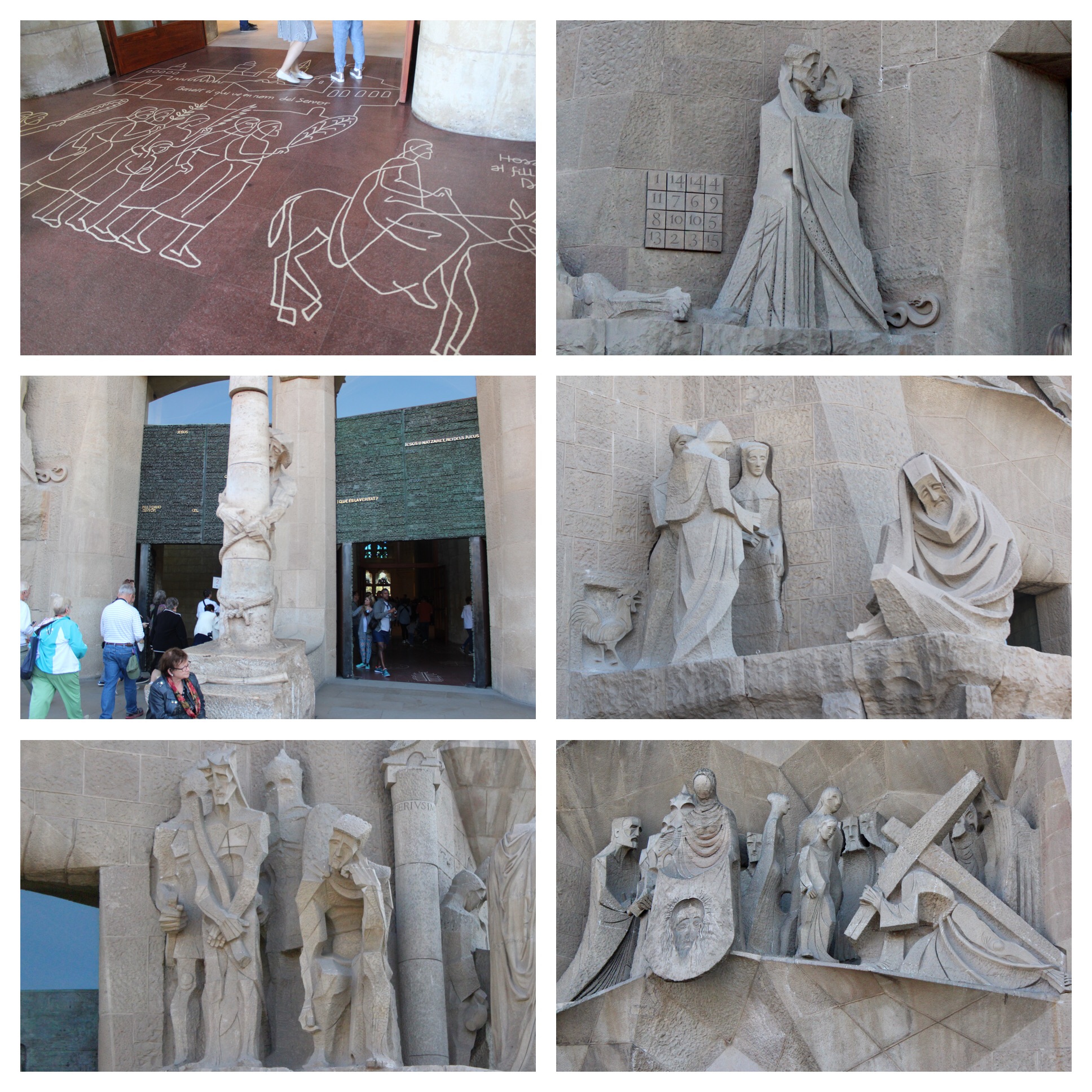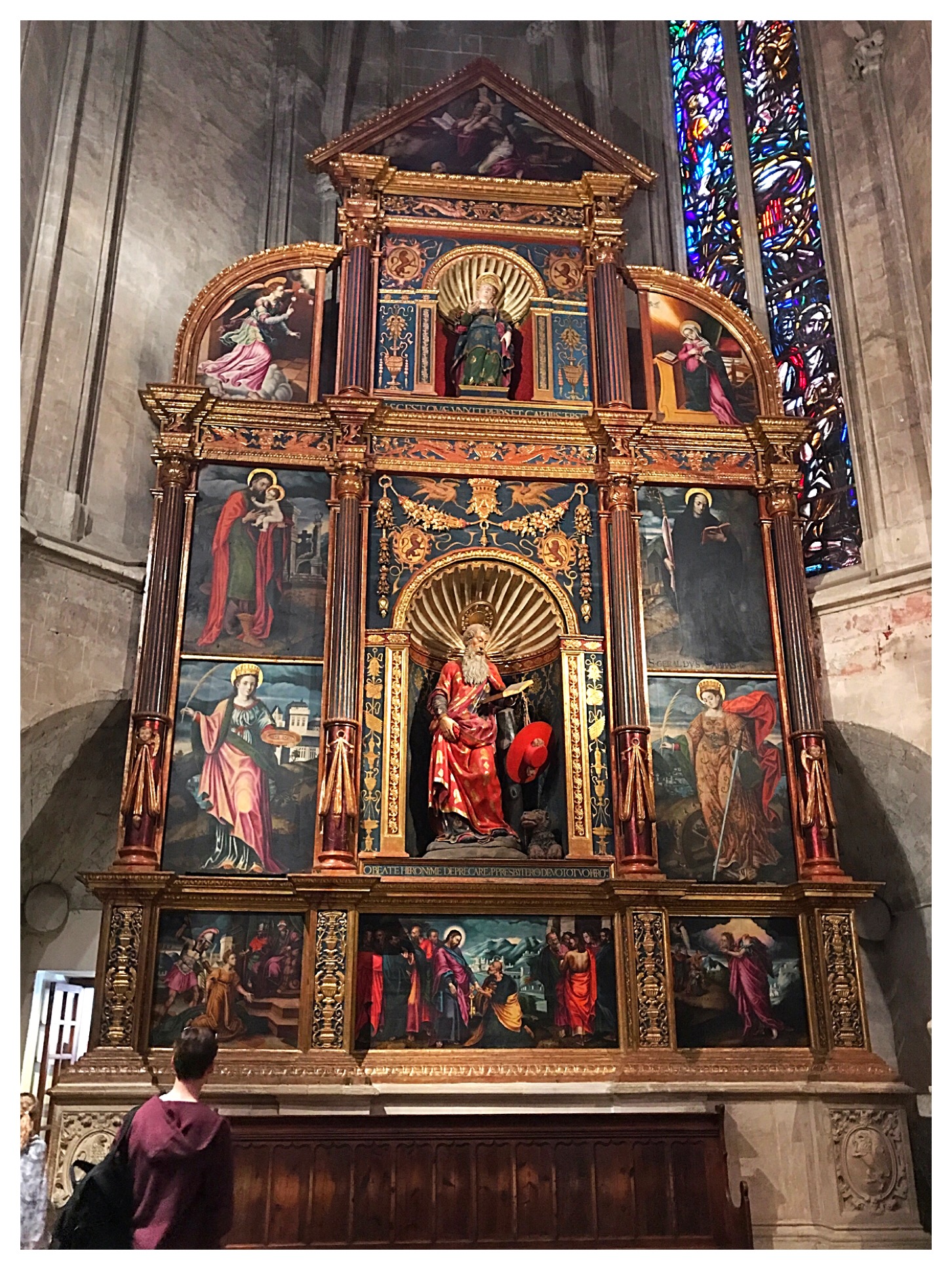


Day 98 of 111, Barcelona, Spain
Besides the churches he worked on, Gaudi was commissioned by several wealthy families to design houses for them. These two houses are located on the Barcelonian version of Rodeo Drive. We passed Gucci and Cartier’s as we walked from the La Pedrera to Casa Batllo. Casa Batllo has an interesting roof that looks like dragon scales. You cannot really see it in my photo so I downloaded one from the internet.
Day 98 of 111. Barcelona, Spain
We are in Barcelona, Spain. The excursion today focused on the works of Antonio Gaudi, a Spanish Catalan architect best known as a practitioner of Catalan Modernism. We toured his best known work, a huge church called the “Sagrada Familia”. It looks like a cathedral but is officially designated as a basilica (a church granted special privileges by the Pope due to the visit by Pope Benedict.) A cathedral is a church that contains the seat of a bishop. Only one church in a region can be a cathedral and a different church already has the bishop’s seat. After visiting the church we visited two homes that were designed by Gaudi: the “La Pedrera” and “Casa Batllo”.

We entered the church through the Passion facade (shown above). The carvings on this side are very modern in shape and portray the story of Christ from the Last Supper to his ascension into heaven. Close ups are shown in the next two collages.


The events shown in detail are: the procession of Christ into Jerusalem (this is from the floor at the entry door); the betrayal of Christ by Judas (note the square of numbers which add up to 33 in any direction; also the snake that represents evil); the flagellation of Christ; Peter’s denial (note the rooster); “Ecce Homo”, behold the man; the fall of Christ on the way to Golgotha (the woman with the veil is identified as Veronica who gave Christ her veil to wipe his forehead. The image of Christ then appeared on her veil. Also note the figure to the left. This is a self portrait of Gaudi, himself); Longinus on this horse; the soldiers playing dice for the tunic of Christ; Christ crucified; descent of Christ’s body from the cross; the entombment; and finally the ascension of Christ into heaven (see the first picture above to see the image’s location between the towers).



Words cannot describe my feelings upon entering the church. Several of us first-time visitors compared our reactions upon entering. “Wow!” was what we said to ourselves. The interior is truly immense. Hanging over the altar is the canopy designed by Gaudi. While the majority of the building is limestone, Gaudi used porphyry for the altar and the surrounding four columns. Porphyry is an extremely strong stone and was used to support the main structure as well as the huge “Jesus” tower that is yet to be built above the altar. Looking up to the ceiling, the support columns appear to be part of a forest.

This church was a very long project (that is not finished). The outside facade with the Nativity is a different, more traditional style, than the outside facade with the Passion. One interesting facets of the design is the greenery in the windows below the Nativity. From the outside (left image) it simply looks like shrubbery but from the inside there is the word “Deus” (God). The window next to it has the same idea, but I did not take the time to decipher the word.

On all of the walls of the church tall stain glass windows fill the walls. Our guide told us that they represent the different seasons of the year with their colors. Everywhere you look there are details and names and symbols worth noting. I liked the bronze doors below the Nativity that had leaves and small animals and insects. The details and symbols in this church would take a year to explore.

What kind of mind is able to conceive and build such an amazing structure? I’ve heard it said that there is a fine line between genius and insanity. Maybe Gaudi was walking that line.


Day 97 of 111. Palma de Mallorca, Spain
We visited the Puerto de Mallorca Bullring. The architecture was interesting as well as the embellishments around doorways, etc. Apparently, there are still bullfights a couple of times a year, but the whole topic is controversial. Our guide went to see bullfights as a child with her grandfather and we could tell she felt it was an important part of her culture. In some parts of Spain, (such as Barcelona), bullfighting was made illegal. Either way, it was interesting to visit the building. We visited during the week before Easter. We found two “floats” that were going to be used for one of the daily processions through town.


The Cathedral de Mallorca, Spain
In the center of town is a huge and distinctive cathedral next to the Almudaina Palace (that appears on the flag of Mallorca). The giant rose window is visible from the outside. Once inside, the light coming through the window was throwing jewel tone lights on the floor and visitors. Two days a year, the Sun is exactly situated to project the rose window on the back wall of the church below another large circular stain glass window.

Antonio Gaudi became involved in the Cathedral de Mallorca at the request of the Bishop. Gaudi worked in Palma from 1904 to 1914 reconfiguring the layout inside the church and brightening the inside by cleaning the walls and windows (black from 600 years of candles), installing electric lights, and building a construction with lamps over the main altar. The inside of the cathedral is impressive to see.



All around the cathedral, there are chapels dedicated to a variety of saints. Each one is different and represents the different centuries. Representing the modern era, the Chapel of the Holy Sacrament was totally reformed by the Majorcan antics, Miguel Barcelo. His huge clay walls rererences the miracle of the loaves and fishes and celebrates the fish in the sea and the plants that grow in Mallorca. The black windows have white streaks that represent the roots of the Tree of Life. Not surprisingly, this installation has caused some controversy.


Bellver Castle, Mallorca, Spain
Our last stop of the tour was to a round-shaped castle on the top of the hill. The round shape is very unusual for castles and is due to the fact that this castle was built by the Templar Knights. From the top of the castle (more steps) we had a wonderful panoramic view of Palma and the harbors next to the city.



Day 95 of 111. Valletta, Malta
Malta is a group of three islands in the Mediterranean below Sicily. It has been an independent nation since 1964, but was an important military base by the British during WWII earning it the George Cross that is part of the Maltese flag. The island itself dates back to the Medieval times and many of the streets still show that ancient heritage as well as the red phone boxes of British occupation. We visited the old capital, Mdina, as well as the modern capital, Valletta. Mdina is known for its variety of door knockers. It was fun seeing the variety and intricacy of these door decorations. Of course, we had to find SOME indication of the Maltese Falcon, this is a sign for a shop.



We arrived at Malta on Palm Sunday, a week before Easter. We visited the St. Paul’s Cathedral just as the mass was ending and the procession of priests were leaving the church. St. Paul was shipwrecked on Malta when he was under arrest and being transported to Rome. He is the patron saint of Malta. We left Mdina and walked around the current capital of Malta, Valletta. The entire city was built in ten years and was laid out in a grid, a pretty modern concept for the fifth century B.C. I really enjoyed the streets and fountains, especially this one with a unicorn. We sat down at a wonderful cafe in Victoria Square and had some local food, local beer, and then a yummy local dessert (hazelnut crumble base with spices, topped with honey and almond… a traditional Maltese Lenten sweet). The dessert came in the shape of the eight-pointed cross, the sign of the Knights of Malta who are the same group as the Knights of St. John that we heard about in Rhodes.


Day 93 of 111. Delos, Greece
Delos was the mythical birthplace of Apollo — god of light and music — and his twin sister Artemis. These were the children of Zeus and Leto. The sacred island is uninhabited, but its earliest settlements date to the 3rd millennium BC. The entire island is an archeological site and was reached by two boat rides (about 35 minutes). We visited in the perfect time, Spring and a little before tourist season. The island was covered with wildflowers and only about 100 visitors were on the five square mile island. Only about one third of the island has been excavated, but most of the walls are original and tables, pedestals, and mosaics were left largely where they were found.


One of the best parts of this island is that it is a complete city that has been preserved and not just the important temples or houses. Shops, temples, streets, the theater, and shrines are represented. Above, we visited a wealthy person’s house with a huge mosaic on the floor. The columns supported the second floor around this open-air atrium. Below the floor was a water reservoir that could be accessed by two wells in the corner of the room. Also, on hot days, the mosaic floor was filled with water that would reflect the light and evaporate to cool the house. On some of the walls (behind Ron) the original plaster still remained.

The theater was less intact than some other areas of the city because it was made of marble. The marble pieces were taken away over time for other building projects after the city became disused. Notice that the front rows had seats with backs on them. The wealthier citizens got those seats and poorer citizens sat farther back, however, the wealthier people paid for the tickets for poorer people as part of their tax. Theatrical entertainment was meant for everyone. A little way down from the theater was a public water reservoir. It would have been covered and small holes would have been where anyone could access the water. The clever thing is that the there is a small trench at the bottom of the front row of theater seats that connects to the reservoir. The entire theater was a rain-collector that helped keep the reservoir filled.


Delos, as the birthplace of Zeus’s son and daughter, was an important pilgrim site. Temples were built to honor Apollo and Artemis and people came from all over to visit them. Because of this attraction, businesses sprang up on the island to support the pilgrims. Rome took over the island and declared it a duty-free zone which further enhanced commerce in the area. Unfortunately, because Rome also had many enemies, the island was attacked and it became disused. The ruins were covered by dirt and plants (see the picture above) which hid/protected the ancient city below. The grassy hill and the ancient buildings shown are next to each other, one has been excavated and the other not. The myth is that Zeus fell in love with Leto and when she had her children, she held onto a palm tree in or near a lake. A palm tree was planted at the supposed spot, but the lake dried up in 1926. The terrace of lions overlooks the lake and face the sunrise. The thought is that these lions demonstrate an influence of Egyptian art.